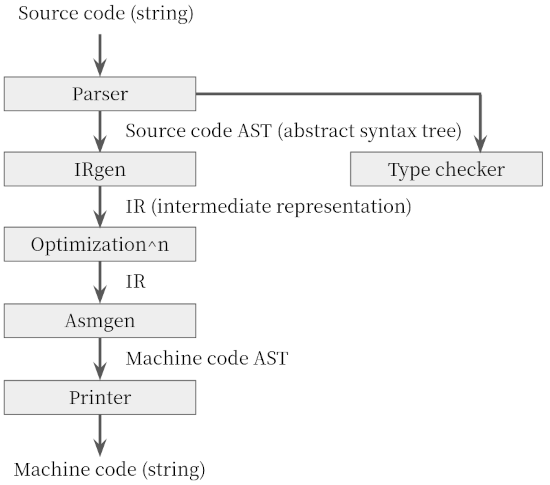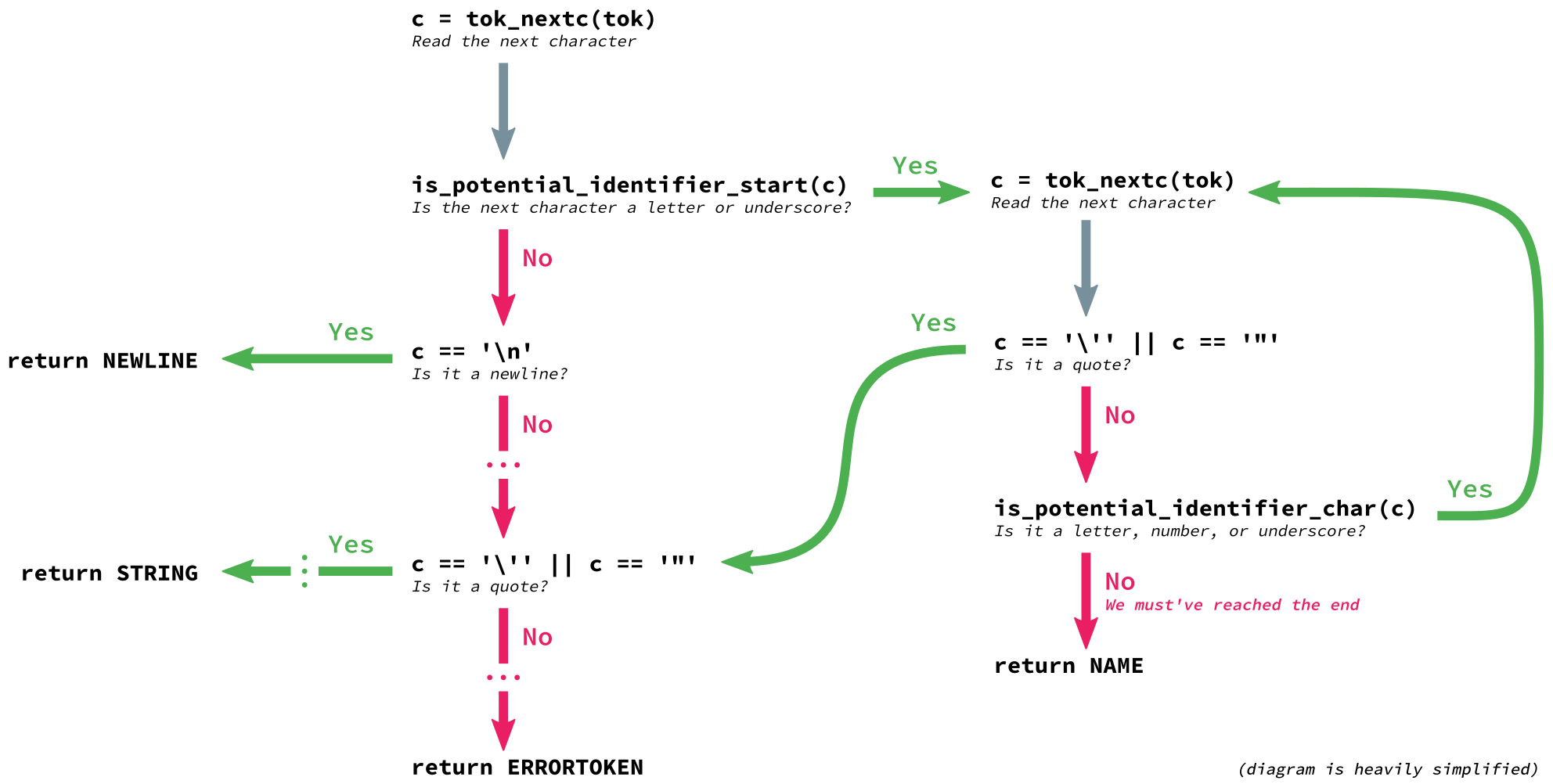CPython Internals: Frontend of Bytecode Compiler
Typically, compilers consist of two parts: a frontend and a backend. This post will cover the frontend of CPython's bytecode compiler, or "how CPython understand the human-readable code?"
All codes in this post are based on CPython v3.10.
Review: Compiler Organization
Typically, compilers consist of following components:

Frontend: Parser & Type Checker
Parser generates the abstract syntax tree (AST) from the raw source code. An AST is a tree representation of source code that reflecting the grammatical aspects into the structure. Each interior node represents an operation while its children represent the arguments. The AST is used intensively during various static analysis, e.g., type checking.
For instance, the following Python snippet
print('Hello, World!')
is converted into the following AST:

Backend: IR Generator, Optimizers & Code Generator
Instead of directly translating to machine-readable code, many compilers generate an intermediate representation (IR), which we can think of as a program for an abstract machine. An IR is designed to be conducive for further optimization steps.
Note that there might exist various levels of intermediate representations, such as control flow graphs (CFG) and register machines.
Lastly, the IR is translated to the machine-readable code. While most compilers generate machine codes that targeting the specific physical architectures (e.g., x86, ARM, ...), CPython translates the IR into the bytecode, which is executed via CPython virtual machine later.
Specification
The grammar of Python can be found in following files:
Grammar/Tokenscontains the token specification.Grammar/python.gramcontains the grammar specification, specified using parser expression grammar (PEG), with corresponding AST nodes.- PEG parser is introduced since CPython v3.9. Before v3.9, CPython used LL(1) parser. See below for details.
Parser/Python.asdlcontains the specification of the AST, specified using Zephyr Abstract Syntax Definition Language.- The definition is independent of its realization in any particular programming language.
Note that various files, including the source code of the parser, are automatically generated from these definitions. Thus, whenever you changed the syntactic definition, you should re-generate those files via running following commands:
# regenerates Include/token.h, Parser/token.c, Lib/token.py
# from Grammar/Tokens
# using Tools/scripts/generate_token.py:
> make regen-token
# regenerates Parser/parser.c
# from Grammar/python.gram and Grammar/Tokens
# using Tools/peg_generator/pegen:
> make regen-pegen
# regenerate Include/Python-ast.h and Python/Python-ast.c
# from Parser/Python.asdl
# using Parser/asdl_c.py:
> make regen-ast
Comparison Between LL(1) vs. PEG
LL(1) is a kind of context-free grammar (CFG). CFG is used by lots of programming languages, although it has some critical limitations. Two problems, ambiguous rules and inability to left-recursive rules, is pointed out in PEP-617. Although the problems might be avoided by generating equivalent LL(1) rules, it may be harder for programmers to catch its meaning.
PEG, on the other hand, cannot suffer from the ambiguity. In addition, while general PEG does not support the left-recursion, CPython's parser allows us to write left-recursive rules. It may include not only the direct recursions, but also complicated rules with indirect or hidden left-recursions.
More details can be found on CPython devguide.
Entrypoints to CPython Tokenizers/Parsers
There are multiple ways to execute CPython binary, stated in pymain_run_python function defined in Modules/main.c:
- Execute with a command via
-cargument, e.g,python -c "print(1 + 3)" - Execute a module via
-margument, e.g.,python -m http.server - Execute a script file
- Execute with a command via stdin, e.g.,
echo "print(1 + 3)" | python - Execute without any arguments to open up the REPL
static void pymain_run_python(int *exitcode) {
/* ... */
PyInterpreterState *interp = _PyInterpreterState_GET();
PyConfig *config = (PyConfig*)_PyInterpreterState_GetConfig(interp);
/* ... */
if (config->run_command) {
*exitcode = pymain_run_command(config->run_command);
} else if (config->run_module) {
*exitcode = pymain_run_module(config->run_module, 1);
} else if (main_importer_path != NULL) {
*exitcode = pymain_run_module(L"__main__", 0);
} else if (config->run_filename != NULL) {
*exitcode = pymain_run_file(config);
} else {
*exitcode = pymain_run_stdin(config);
}
pymain_repl(config, exitcode);
/* ... */
}
For each method, CPython calls different tokenizers and/or parsers.
- All
pymain_run_file,pymain_run_stdinandpymain_replrely on_PyRun_AnyFileObject, which uses_PyParser_ASTFromFile. _PyParser_ASTFromStringis called when CPython is executed viapymain_run_command.- When executing via
pymain_run_module, CPython wraps the module usingrunpy._run_code, which loads the code objects via built-inexec. If the module has not been compiled yet, CPython runscompileon the module, which calls_PyParser_ASTFromString(seebuiltin_compile_implinPython/bltinmodule.c).
Source Code to Tokens
First of all, the source code is grouped into meaningful sequences of tokens. Each token can have a token name and an optional attribute value. For instance, the code
print('Hello, World!')
can be tokenized into:
0,0-0,0: ENCODING 'utf-8'
1,0-1,5: NAME 'print'
1,5-1,6: OP '('
1,6-1,21: STRING "'Hello, World!'"
1,21-1,22: OP ')'
1,22-1,23: NEWLINE '\n'
2,0-2,0: ENDMARKER ''
Parser consumes those tokens and builds the AST. If you're interested in how the CPython tokenizer works, see tok_get function defined in Parser/tokenizer.c, or see the excellent post by Benjamin Woodruff. This post won't cover the tedious details :)

Tokens to Abstract Syntax Tree
Both _PyParser_ASTFromString and _PyParser_ASTFromFile are thin wrapper of _PyPegen_run_parser, which internally calls _PyPegen_parse in Grammar/python.gram:
void* _PyPegen_parse(Parser *p) {
/* ... */
void *result = NULL;
if (p->start_rule == Py_file_input) {
result = file_rule(p);
} else if (p->start_rule == Py_single_input) {
result = interactive_rule(p);
} else if (p->start_rule == Py_eval_input) {
result = eval_rule(p);
} else if (p->start_rule == Py_func_type_input) {
result = func_type_rule(p);
} else if (p->start_rule == Py_fstring_input) {
result = fstring_rule(p);
}
return result;
}
Each rule function generates an AST tree until all non-terminal symbols are replaced and returns its root node. AST nodes are C structs generated from their definition. For instance, file_rule returns the following struct representing the mod node
enum _mod_kind {
Module_kind=1,
Interactive_kind=2,
Expression_kind=3,
FunctionType_kind=4
};
struct _mod {
enum _mod_kind kind;
union {
struct {
asdl_stmt_seq *body;
asdl_type_ignore_seq *type_ignores;
} Module;
struct {
asdl_stmt_seq *body;
} Interactive;
struct {
expr_ty body;
} Expression;
struct {
asdl_expr_seq *argtypes;
expr_ty returns;
} FunctionType;
} v;
};
which is generated from the following definition:
mod = Module(stmt* body, type_ignore* type_ignores)
| Interactive(stmt* body)
| Expression(expr body)
| FunctionType(expr* argtypes, expr returns)
Notice that _PyPegen_run_parser might call _PyPegen_parse twice if the first attempt has failed. This is because the second parsing can use additional rules thus the error report can be enhanced. Since using these custom rules has severe degradation, CPython applies these rules only if an error occurs.
void * _PyPegen_run_parser(Parser *p) {
void *res = _PyPegen_parse(p);
if (res == NULL) { // parser has failed
// some exception has been raised
if (PyErr_Occurred() && !PyErr_ExceptionMatches(PyExc_SyntaxError))
return NULL;
// reset parser and parse again
Token *last_token = p->tokens[p->fill - 1];
reset_parser_state(p);
_PyPegen_parse(p);
/* ... */
// notice that the second attempt always failed
return NULL;
}
/* ... */
}
The rules for the error reports starts with invalid_. For instance, the following rule
invalid_kwarg:
| a=NAME b='=' expression for_if_clauses {
RAISE_SYNTAX_ERROR_KNOWN_RANGE(a, b,
"invalid syntax. Maybe you meant '==' or ':=' instead of '='?")}
| !(NAME '=') a=expression b='=' {
RAISE_SYNTAX_ERROR_KNOWN_RANGE(
a, b,
"expression cannot contain assignment, perhaps you meant \"==\"?")}
will be raised in the following situations:
>>> x = 3
>>> if x = 3: x += 1
File "<stdin>", line 1
if x = 3: x += 1
^^^^^
SyntaxError: invalid syntax. Maybe you meant '==' or ':=' instead of '='?
>>> y = dict(1=2)
File "<stdin>", line 1
y = dict(1=2)
^^
SyntaxError: expression cannot contain assignment, perhaps you meant "=="?
Reference
- Various resources on compilers
- Alfred V. Aho and others, Compilers: Principles, Techniques, and Tools (2/E).
- KAIST CS420: Compiler Design
- Various articles from CPython Devguide
- Benjamin Woodruff, A Deep Dive into Python's Tokenizer.